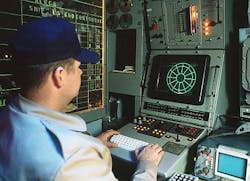Lockheed Martin to build shipboard electronic warfare prototypes in $39.1 million contract
WASHINGTON, 30 May 2013. Engineers at the Lockheed Martin Corp. Radar Systems segment in Liverpool, N.Y., will build advanced-development prototypes of the U.S. Navy Surface Electronic Warfare Improvement Program (SEWIP) Block 2 system under terms of a $39.1 million contract modification announced Wednesday.
Officials of the Naval Sea Systems Command in Washington are awarding the contract to Lockheed Martin to buy SEWIP Block 2 low-rate initial production (LRIP) units.
The SEWIP program is upgrading the Navy's existing AN/SLQ-32(V) electronic warfare system by improving the receiver and antenna group to meet current and anticipated threats, as well as to yield improved system integration, Navy officials say.
LRIP describes initial, small-quantity production of a weapons system for extensive field testing and evaluation previous to contracts for full-rate production. LRIP typically is the first step in moving from custom prototypes to the final mass-produced end product.
Since the SEWIP program started in 2002, General Dynamics Advanced Information Systems (AIS) in Fairfax, Va., acted as prime contractor for SEWIP blocks 1A, 1B1, 1B2, and 1B3. Lockheed Martin Radar Systems won a Navy award for block 2 in late 2009, leading a team of ITT Electronic Systems, Cobham Defence Electronic Systems, Research Associates Syracuse, and Azure Summit Technology of Fairfax, Va.
The team conducted a preliminary design review in 2010, leading to funding for engineering development models and eventually, low-rate production.
The Lockheed Martin Block 2 SEWIP design is based on its integrated common electronics warfare system (ICEWS), which enables rapid reconfiguring of the system with commercial technology.
Mercury Systems in Chelmsford, Mass., for example, is providing advanced radio frequency (RF) microwave tuners and intermediate frequency (IF) products for SEWIP Block 2. Lockheed Martin chose the Mercury Echotek series microwave tuner and digital receiver, which are optimized for fast tuning and high performance, Mercury officials say.
In early 2012, Raytheon Co. and Lockheed Martin formed a team to capture a Navy award for the system's newest generation, SEWIP Block 3. The different SEWIP variants will provide more effective capability for countering hostile electronic signals actively and passively.
The Lockheed Martin-Raytheon team demonstrated the Block 3 SEWIP last year during the RIMPAC naval exercise in the Pacific.
Developed by Raytheon in the 1970s, the original AN/SLQ-32 systems employed passive radar technology for early warning, identification and tracking of enemy threats. Subsequent upgrades provided an additional active capability for simultaneous jamming of multiple threats.
On the current contract modification, Lockheed Martin will do the work in Syracuse, N.Y., and Lansdale, Pa., and should be finished by September 2014.
For more information contact Lockheed Martin Radar Systems online at www.lockheedmartin.com, or Naval Sea Systems Command at www.navsea.navy.mil.

